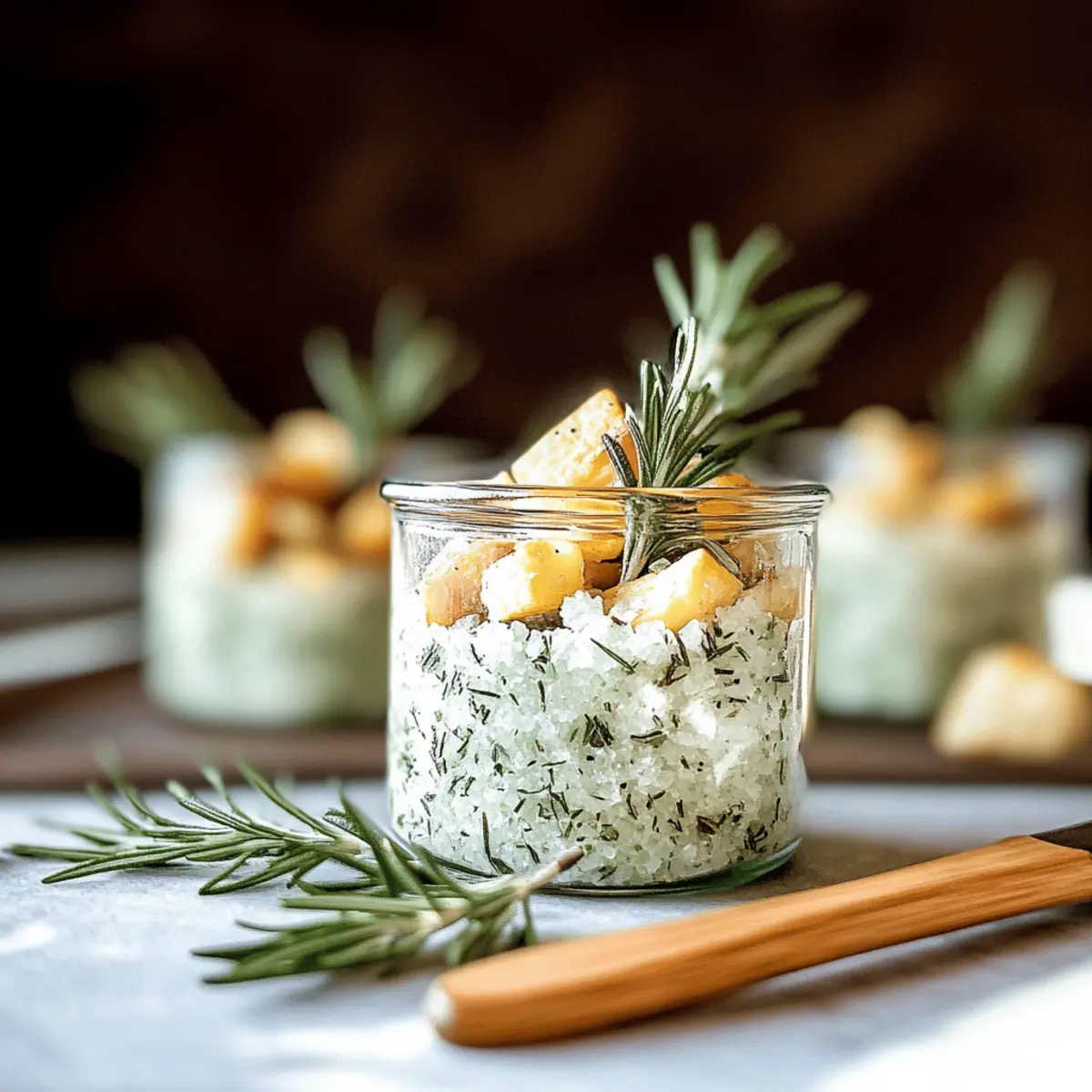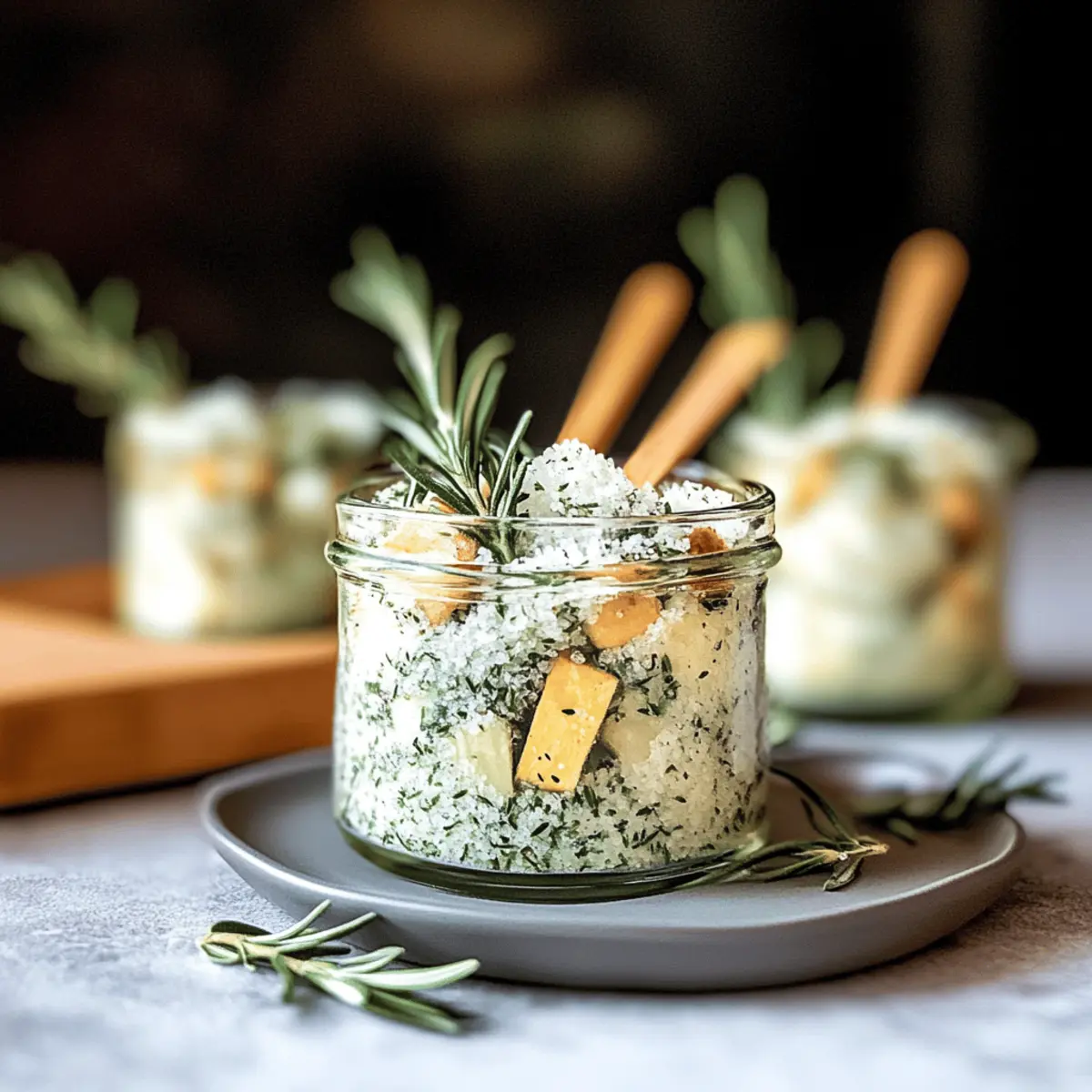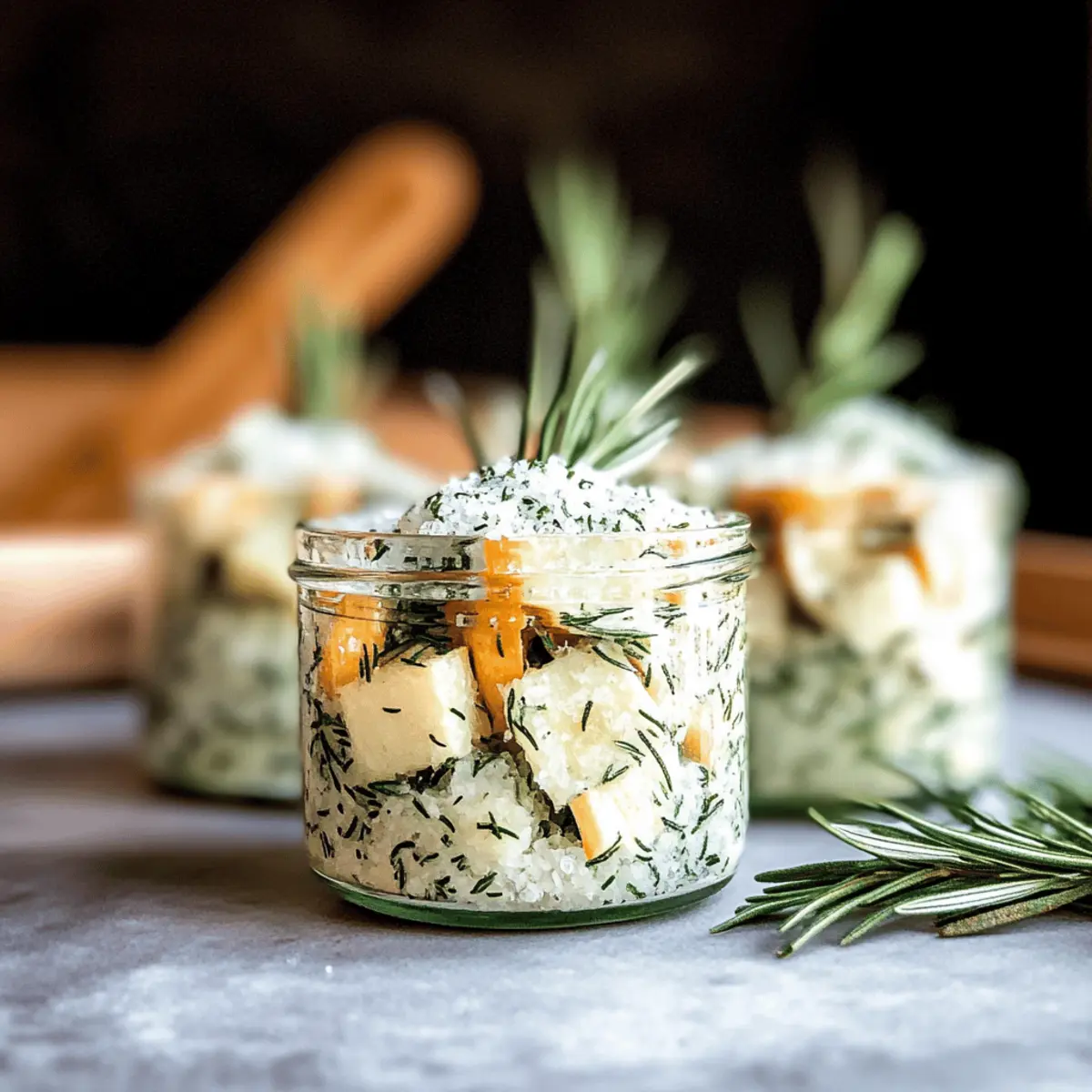As I stood in my kitchen, the aromatic scent of fresh rosemary enveloped me, transporting me to sun-drenched Mediterranean fields. Making homemade rosemary salt is like capturing that essence in a jar, ready to sprinkle over your meals! This delightful recipe transforms ordinary dishes into culinary masterpieces while being incredibly easy to whip up. Not only is it a gluten-free and vegan-friendly seasoning, but it also serves as a fun, flavorful way to impress your family and friends. Use it to elevate roasted vegetables, season grilled meats, or finish off a warm loaf of focaccia with a generous sprinkle. Curious to discover just how simple and transformative this rosemary salt can be? Let’s dive into the details!

Why is Rosemary Salt a Must-Try?
Flavor Booster: This homemade seasoning is your secret weapon for elevating everyday dishes. Just a sprinkle of rosemary salt transforms the taste of even the simplest meals!
Quick and Easy: With just 5 minutes of prep and a little drying time, you can whip up this delightful blend without breaking a sweat.
Versatile Use: Perfect for enhancing roasted veggies, grilled proteins, or even popcorn, it’s a multifunctional seasoning that fits seamlessly into your kitchen routine. Pair it with roasted garlic and herbs for a unique twist!
Crowd-Pleasing Gift: Put your culinary skills on display by gifting this delightful salt in a pretty jar; it’s a thoughtful, homemade treat for family or friends that will surely impress.
Flavorful and Healthy: With only 0.2 kcal per teaspoon, this gluten-free and vegan-friendly salt enhances flavors without adding unnecessary calories—perfect for any health-conscious cook!
Feel inspired? Try it today and discover the magic of rosemary salt in your cooking adventures!
Rosemary Salt Ingredients
• Ready to create your own flavorful twist?
For the Rosemary Salt
- Coarse Sea Salt – This provides the essential base for your homemade seasoning; if you want a milder taste, feel free to substitute with kosher salt.
- Fresh Rosemary Leaves – Adds a bold, aromatic flavor; if fresh is not available, you can use frozen rosemary as an alternative.
For Optional Storage
- Airtight Container – Use a glass jar or plastic container to keep your rosemary salt fresh and flavorful for up to 6 months.
Make this delicious rosemary salt and let it elevate your meals to a whole new level!
Step‑by‑Step Instructions for Rosemary Salt
Step 1: Preheat the Oven
Begin by preheating your oven by simply turning on the light. This will create a warm environment for your rosemary salt to dry without any direct heat. The oven itself should not be on, allowing it to warm gently to about 100°F to 120°F. This low temperature will help preserve the vibrant color and flavor of the rosemary.
Step 2: Prepare Your Baking Sheet
Line a baking sheet with parchment paper to create a non-stick surface for your rosemary salt mixture. This step is crucial for easy cleanup and ensures an even drying process. The parchment paper will help maintain the integrity of the salt and rosemary, making it a seamless experience when you transfer your mixture later.
Step 3: Harvest Fresh Rosemary
Carefully remove the leaves from the fresh rosemary sprigs to yield about ½ cup of leaves. As you do this, be sure to inspect the rosemary for any unwanted stems or imperfections. This step is essential, as the freshness of the rosemary leaves will significantly enhance the flavor profile of your homemade rosemary salt.
Step 4: Blend Ingredients in Food Processor
In a food processor, combine the freshly harvested rosemary leaves with 1 ½ cups of coarse sea salt. Pulse the mixture until you achieve a chunky yet slightly blended consistency—you’ll want to see flecks of green amid the salt. This process should take about 30 seconds to 1 minute, giving you a beautifully fragrant rosemary salt.
Step 5: Spread and Dry the Mixture
Evenly spread the rosemary salt mixture onto your prepared baking sheet, creating a thin layer. Place the baking sheet in the preheated oven (remember, just with the light on) and let it dry for approximately 2 hours. Stir the mixture every 30 minutes to ensure even drying. You can also opt for air-drying at room temperature for 4-5 hours if preferred.
Step 6: Check for Proper Dryness
After the drying time is complete, check the rosemary salt for doneness. The mixture should feel airy and resemble a sandy texture, with no moisture left. This crucial step ensures that your homemade rosemary salt won’t clump together when stored. Take your time with this, as fully dried salt will provide the best flavor when used in your dishes.
Step 7: Store Your Rosemary Salt
Once completely dry, transfer the rosemary salt into an airtight container to preserve its freshness and flavor. Glass jars work wonderfully for this purpose, as they not only keep the salt sealed but also look charming on your kitchen shelf. Remember to store your rosemary salt in a cool, dark space, and it should retain its vibrant flavor for up to six months.

Variations & Substitutions for Rosemary Salt
Feel free to get creative and tailor this rosemary salt recipe to your taste buds or dietary needs!
-
Dairy-Free: Substitute traditional sea salt with a flavored sea salt or a smoked variety for added pizzazz.
-
Herbal Fusion: Mix in dried thyme or oregano for a unique flavor twist. This added herbaceous combo opens up new culinary possibilities!
-
Spicy Kick: Incorporate a pinch of cayenne pepper or crushed red pepper flakes to elevate heat levels for a zesty flair that’ll excite your palate.
-
Zesty Lemon: Add lemon zest to the salt mixture before drying for a refreshing citrus twist. The bright zing complements the rosemary and brightens up grilled dishes wonderfully.
-
Smoky Flavor: Use smoked sea salt instead of regular salt for a deep, robust taste that complements meats and grilled veggies.
-
Nutty Essence: Mix in ground rosemary with a tablespoon of ground walnuts or pecans for a rich, nutty finish. This will enhance the texture, adding delightful crunch to your seasonings.
-
Garlic Lover’s: Blend in dehydrated garlic powder to create a savory garlic and rosemary fusion that’s perfect for steak or roasted potatoes. It’s great for those comforting weeknight dinners!
-
Herb Salt: Create a multi-herb seasoning by mixing rosemary with basil, parsley, or dill for a burst of flavors reminiscent of Mediterranean cuisine, perfect for drizzling on vegetable dishes or salads.
No matter how you choose to customize your rosemary salt, each variation offers a new way to elevate your homemade meals. Ready to explore? Why not also try sprinkling this aromatic concoction over lavish grilled vegetables or a beautiful piece of grilled fish? Let the magic of flavor guide you!
What to Serve with Rosemary Salt
There’s nothing quite like a meal seasoned with homemade rosemary salt to awaken your taste buds and elevate your dining experience.
- Grilled Chicken: The herbaceous notes of rosemary salt enhance the savory flavors, bringing out the best in your chicken dish.
- Roasted Potatoes: Crispy on the outside and fluffy within, a sprinkle of rosemary salt makes these delightful potatoes sing with flavor.
- Sautéed Greens: Bright flavors of kale or spinach shine when seasoned with rosemary salt, adding a fresh, vibrant touch to your plate.
- Focaccia Bread: Perfect with a drizzle of olive oil, rosemary salt transforms warm focaccia into an irresistible appetizer or side.
- Braised Lamb Chops: This rich dish pairs beautifully with rosemary salt, complementing the meat’s robustness and enhancing the overall taste harmony.
- Seared Salmon: The delicate fish finds balance with a light dusting of rosemary salt, boosting its natural flavor and adding a hint of earthiness.
- Vegetable Stir-Fry: Enhance a colorful medley of veggies with rosemary salt, which ties together the crisp textures and diverse flavors beautifully.
- Craft Cocktails: Rim your glasses with rosemary salt for a unique twist in cocktails—adding freshness and a touch of elegance.
- Dark Chocolate Desserts: A sprinkle of rosemary salt over rich, dark chocolate desserts creates a captivating flavor contrast that leaves you wanting more.
- Herbed Rice Pilaf: Fluffy rice shines when dressed with rosemary salt, making it a stunning and fragrant addition to any meal.
Expert Tips for Rosemary Salt
-
Dry it Right: Ensure the rosemary salt is fully dry before storage; it should feel airy and sandy. This prevents clumping, so take your time!
-
Mix It Up: Consider blending different sea salts for unique flavor profiles. Experiment to find your favorite combo with this homemade seasoning!
-
Storing Secrets: Use an airtight container to keep your rosemary salt fresh and flavorful. Store it in a cool, dark place for best results.
-
Batch It: Make larger batches to share with friends or to ensure you have enough on hand for all your culinary adventures!
-
Check Freshness: If you’re using dried herbs, make sure they are fresh and vibrant. Old herbs can dull the lively flavor of your rosemary salt.
Make Ahead Options
These homemade rosemary salt preparations are a busy cook’s dream! You can easily blend the rosemary and salt mixture up to 24 hours in advance, allowing the flavors to meld beautifully. Simply follow the initial steps of removing and blending the rosemary leaves with the coarse sea salt, then spread the mixture on a baking sheet to dry. If you need to prep even further ahead, the dried rosemary salt can be stored in an airtight container for up to 3 months. Just remember to keep it in a cool, dark space to maintain its vibrant flavor. When you’re ready to elevate your meals, simply sprinkle it on your dishes or use it as a finishing touch; it’ll be just as delicious as when you made it fresh!
How to Store and Freeze Rosemary Salt
Airtight Container: Store your homemade rosemary salt in a sealed glass jar or plastic container to keep it fresh for up to 6 months, maintaining its vibrant flavor.
Cool, Dark Space: Keep the container in a cool, dark cupboard, away from direct sunlight and moisture, which can affect the quality of your flavored salt.
Check for Clumping: Before using your rosemary salt, ensure that it hasn’t clumped together. If it has, simply break it apart with a fork for easy sprinkling.
Gifting Tip: Consider packaging your rosemary salt in a decorative jar for a delightful homemade gift; just be sure to include a note about proper storage!

Rosemary Salt Recipe FAQs
How do I choose the best rosemary for my salt?
Absolutely! When selecting fresh rosemary, look for vibrant green leaves without any dark spots or wilting. The leaves should feel firm and fragrant. If fresh rosemary isn’t available, frozen rosemary works as a suitable alternative, though the flavor intensity may be slightly diminished.
How should I store rosemary salt to maximize freshness?
To keep your homemade rosemary salt fresh, store it in an airtight container, like a glass jar or plastic container, in a cool, dark place, such as a spice cupboard. This will maintain its vibrant flavor and should last for up to 6 months. A good rule of thumb is to keep it away from direct sunlight and moisture for optimal quality.
Can I freeze rosemary salt?
Yes! Freezing rosemary salt is a great way to extend its shelf life. To do this, simply spoon the salt into an airtight freezer-safe container or a resealable plastic bag. Lay it flat to freeze and store it in the freezer for up to 3 months. When you’re ready to use it, just take out the amount you need and let it thaw at room temperature.
What should I do if my rosemary salt clumps together?
If your rosemary salt has clumped together, no worries at all! Just take a fork and gently break apart the clumps. The key is to ensure that the salt was completely dry before storage; a sandy texture indicates it’s ready. To prevent future clumping, keep it sealed properly and store it in a cool, dry place.
Is rosemary salt safe for pets?
Very! While rosemary itself is generally safe for pets in small amounts, as with any seasoning, it’s wise to use it sparingly. If your pet has specific health concerns or dietary restrictions, consult your veterinarian. Always keep your cooking ingredients away from pets and educate yourself on any seasonings you are unsure about!
Can I use other herbs to make flavored salts?
Absolutely! Rosemary salt is just the beginning; feel free to experiment with other herbs like thyme, oregano, or basil. Mixing different herbs in the same process can offer unique flavor profiles that adapt beautifully to various dishes and delight your taste buds. Enjoy the creative process!

Rosemary Salt Magic: Transform Your Meals with Homemade Flavor
Ingredients
Equipment
Method
- Preheat your oven by simply turning on the light to create a warm environment for your rosemary salt to dry.
- Line a baking sheet with parchment paper to create a non-stick surface for your rosemary salt mixture.
- Harvest about ½ cup of fresh rosemary leaves, inspecting for any unwanted stems or imperfections.
- In a food processor, combine the rosemary leaves with 1 ½ cups of coarse sea salt and pulse until slightly blended.
- Spread the rosemary salt mixture onto the prepared baking sheet in a thin layer and let it dry for about 2 hours.
- Check the rosemary salt for doneness, ensuring it feels airy and resembles a sandy texture.
- Transfer the fully dried rosemary salt into an airtight container to preserve its freshness.

Leave a Reply